Today’s post is about the settlement of Jamestown. Oh, not the Jamestown founded in 1607 on the banks of the Powhatan River in the colony of Virginia and named for England’s King James I. This Jamestown was founded in 1905 on the tracks of the Texas & Pacific railroad in the town of Polytechnic and named for the family of Thomas Randle James.
Thomas Randle James was born in Georgia in 1826. John Quincy Adams was president. There were twenty-four states in the Union.
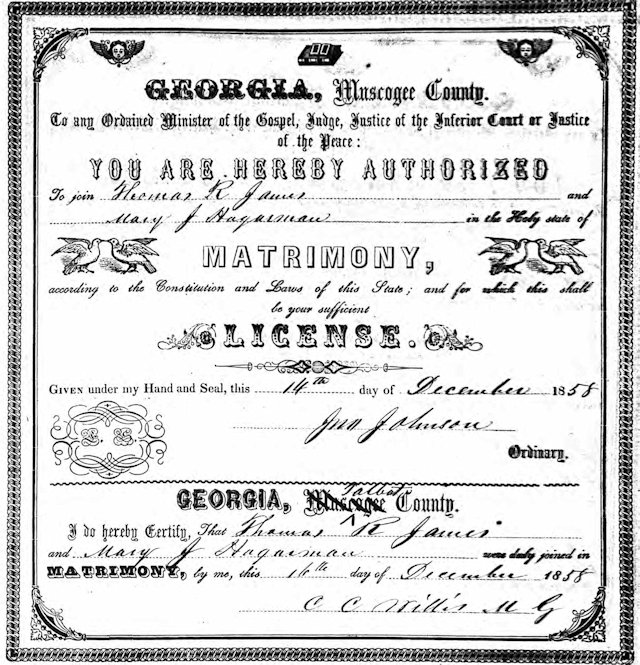 In 1858 James married Mary Hagerman.
In 1858 James married Mary Hagerman.
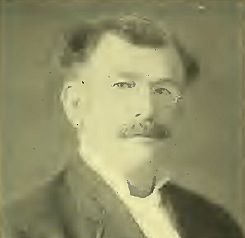
Their son Walter was born in Georgia in 1860. By March 1862 the Jameses were living in Alabama. That month son William (pictured) was born, and father Thomas Randle enlisted in the Confederate army. William attended public school through age twelve.
 After the war the Jameses moved to Texas. By 1873 they were living in Cleburne, where Thomas operated T. R. James Company. He made saddles and harnesses. He was proud of his name, his company, and his sons. When sons Walter and William learned the trade and joined the family business, T. R. renamed his company “T. R. James & Sons.”
After the war the Jameses moved to Texas. By 1873 they were living in Cleburne, where Thomas operated T. R. James Company. He made saddles and harnesses. He was proud of his name, his company, and his sons. When sons Walter and William learned the trade and joined the family business, T. R. renamed his company “T. R. James & Sons.”
Son William married Kalita Bridget O’Brien in Jefferson County in 1886. Their son Thomas Randle Jr., named after William’s father, was born in 1887.
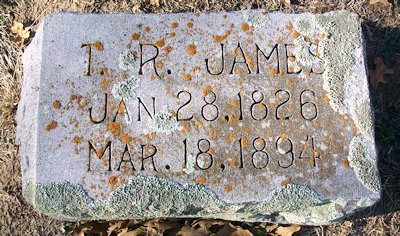
Thomas Randle James died in 1894.
 But sons Walter and William continued the family business as “T. R. James & Sons.”
But sons Walter and William continued the family business as “T. R. James & Sons.”
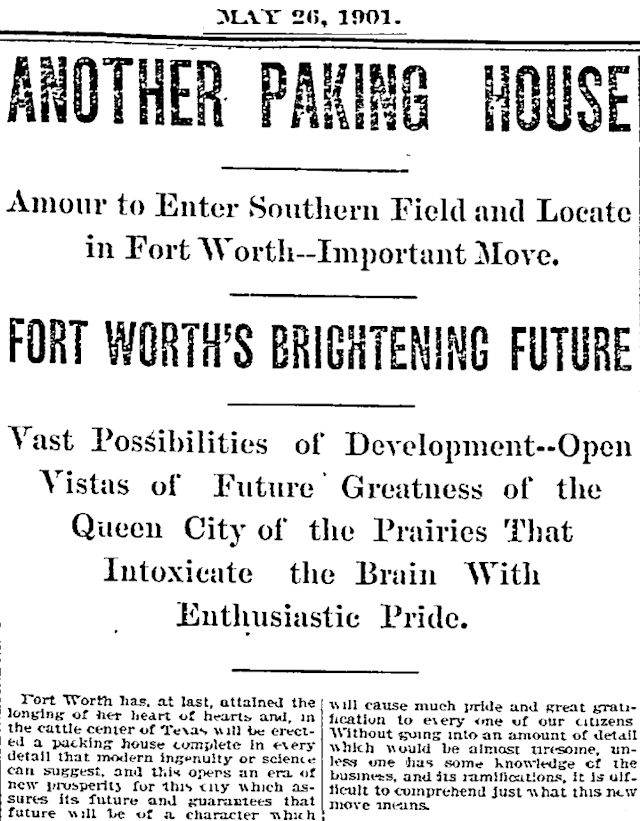 In April 1901 the James brothers moved their company to Fort Worth. Their timing surely was no coincidence: Fort Worth had been trying to entice Armour and Swift companies to build a packing plant here. One month after the James brothers moved here, Armour announced that it indeed would build a packing plant here. Swift soon followed suit. The two packing plants provided plenty of hides for the brothers’ wholesale leather goods company.
In April 1901 the James brothers moved their company to Fort Worth. Their timing surely was no coincidence: Fort Worth had been trying to entice Armour and Swift companies to build a packing plant here. One month after the James brothers moved here, Armour announced that it indeed would build a packing plant here. Swift soon followed suit. The two packing plants provided plenty of hides for the brothers’ wholesale leather goods company.
 The brothers set up shop on West 3rd Street downtown. (“Findings” are supplies.)
The brothers set up shop on West 3rd Street downtown. (“Findings” are supplies.)
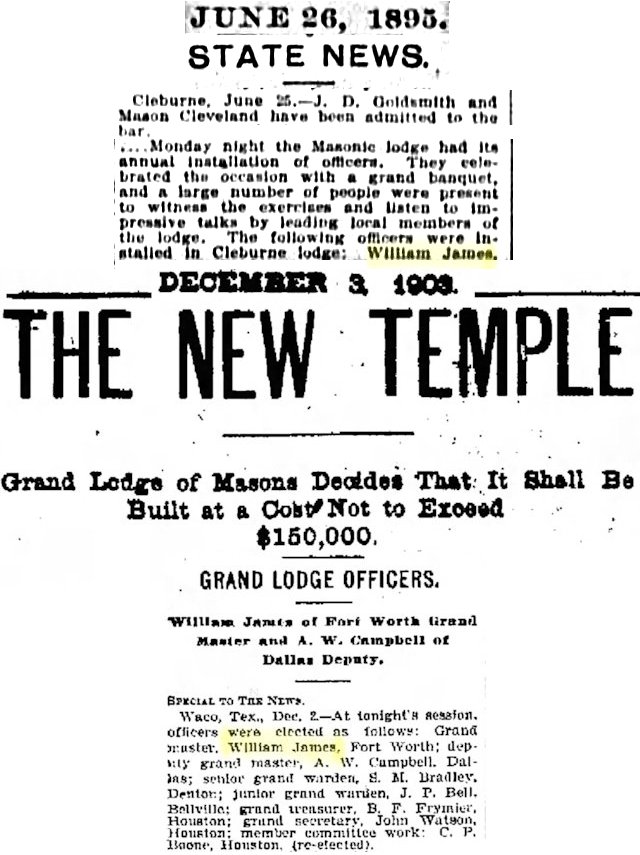 William James had long been a Mason. In 1903 he was elected grand master of Texas Masonry.
William James had long been a Mason. In 1903 he was elected grand master of Texas Masonry.
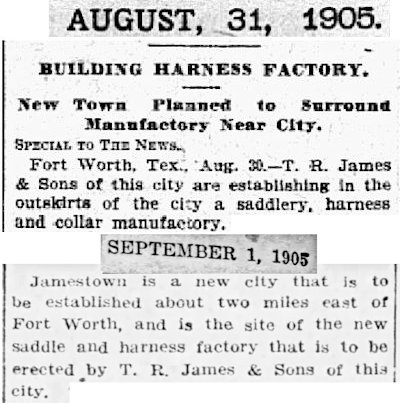
The James brothers prospered in their new town. In 1905 they announced big plans. The Telegram and the Dallas Morning News reported that the brothers had bought thirty-five acres in the unincorporated town of Polytechnic Heights two miles east of town. On that land the brothers would build a factory to make saddles, harnesses, and collars.
The factory, employing 150 workers, would make sixty-two styles of saddles and fifty styles of harnesses.
The factory would be served by a siding from the nearby Texas & Pacific tracks.
The two brothers envisioned not only “a model manufacturing plant” but also a “new city” that would grow up around the plant.
The brothers, like the father, were proud of the “James” name.
The Morning News wrote: “It is the intention [of the brothers] to establish a town, to be designated as Jamestown.”
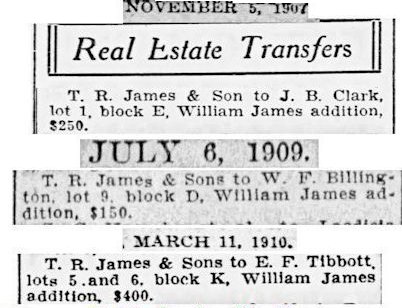
The brothers would use the thirty-five acres to seed their city. They had bought more land than they needed for their factory. They platted the surplus land into lots and sold the lots for houses, including houses for James factory workers. This was a common money-making practice for companies and institutions (for example, the stove foundry, bolt factory, wagon factory, and seminary).
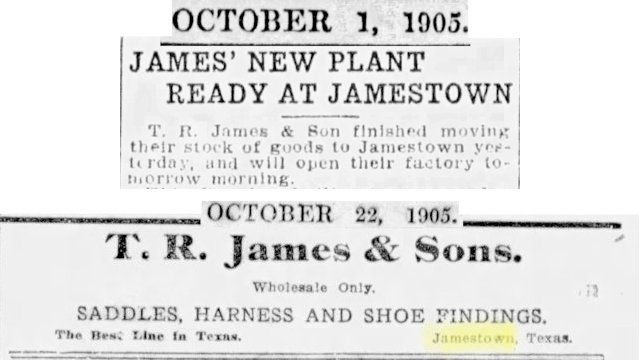 In October 1905 the new factory opened at “Jamestown.” The children of Jamestown workers attended the school at Manchester Mills one mile to the east.
In October 1905 the new factory opened at “Jamestown.” The children of Jamestown workers attended the school at Manchester Mills one mile to the east.
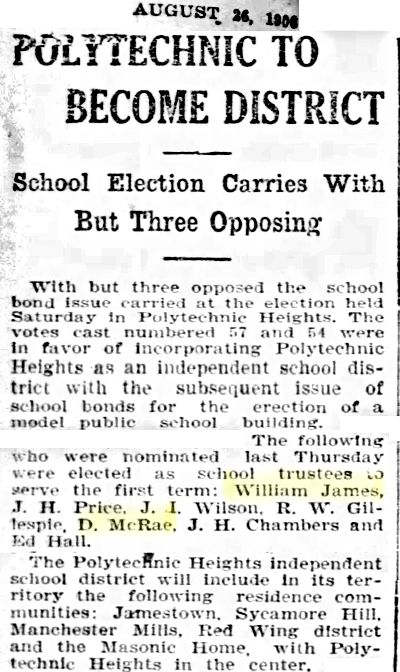 Brother William soon became involved in Polytechnic civic affairs. He helped organize the Polytechnic school district in 1906, was a trustee, along with Duncan McRae. The district included Jamestown as well as Manchester Mills and Masonic Home.
Brother William soon became involved in Polytechnic civic affairs. He helped organize the Polytechnic school district in 1906, was a trustee, along with Duncan McRae. The district included Jamestown as well as Manchester Mills and Masonic Home.
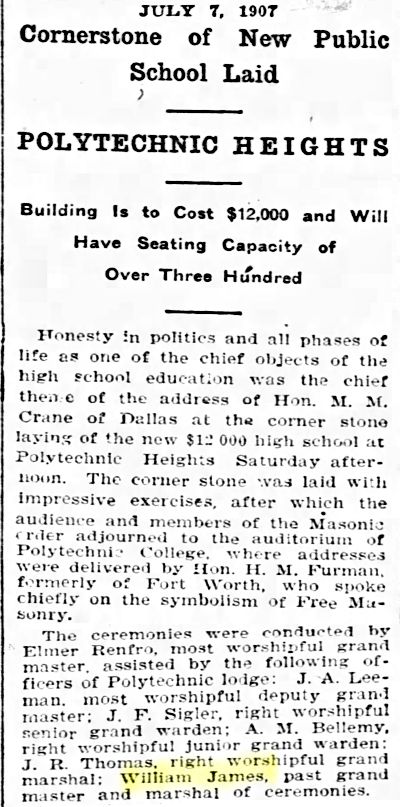
When the Polytechnic school district laid the cornerstone for its high school in 1907, William James was among those officiating at the ceremony.
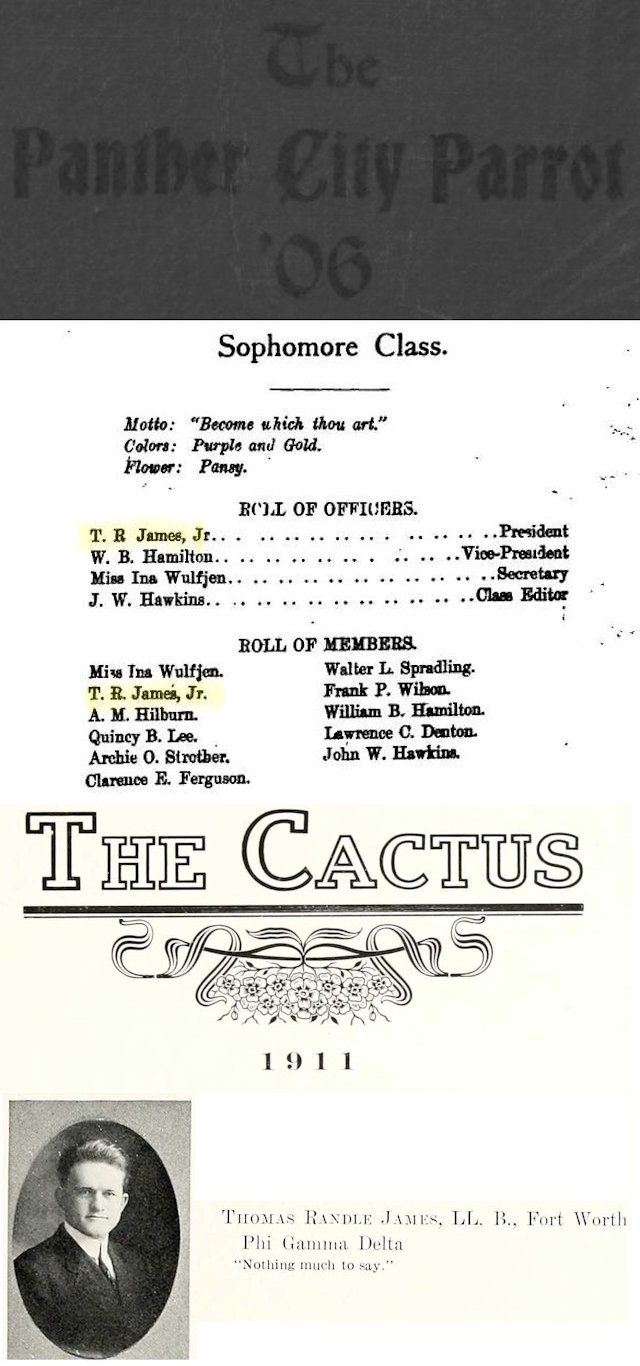 Meanwhile, four blocks away William’s son Thomas Randle James Jr. attended Polytechnic College, where he was befriended by future U.S. Capitol bomber Erich Muenter (alias “Frank Holt”). Thomas Randle James Jr. began his law practice in 1912. He died in 1970.
Meanwhile, four blocks away William’s son Thomas Randle James Jr. attended Polytechnic College, where he was befriended by future U.S. Capitol bomber Erich Muenter (alias “Frank Holt”). Thomas Randle James Jr. began his law practice in 1912. He died in 1970.
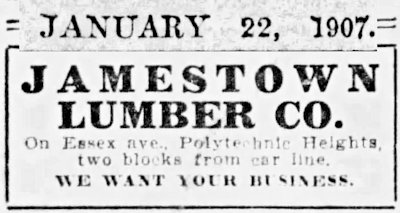
The notion of Jamestown as a separate town was slow to catch on. The only so-named business I have found is Jamestown Lumber Company, located on Essex Street just south of the James factory.

In 1908 the factory was seeking boys to learn the “horse collar trade.” “Interurban road” was East Lancaster Avenue, which ran alongside the interurban track.
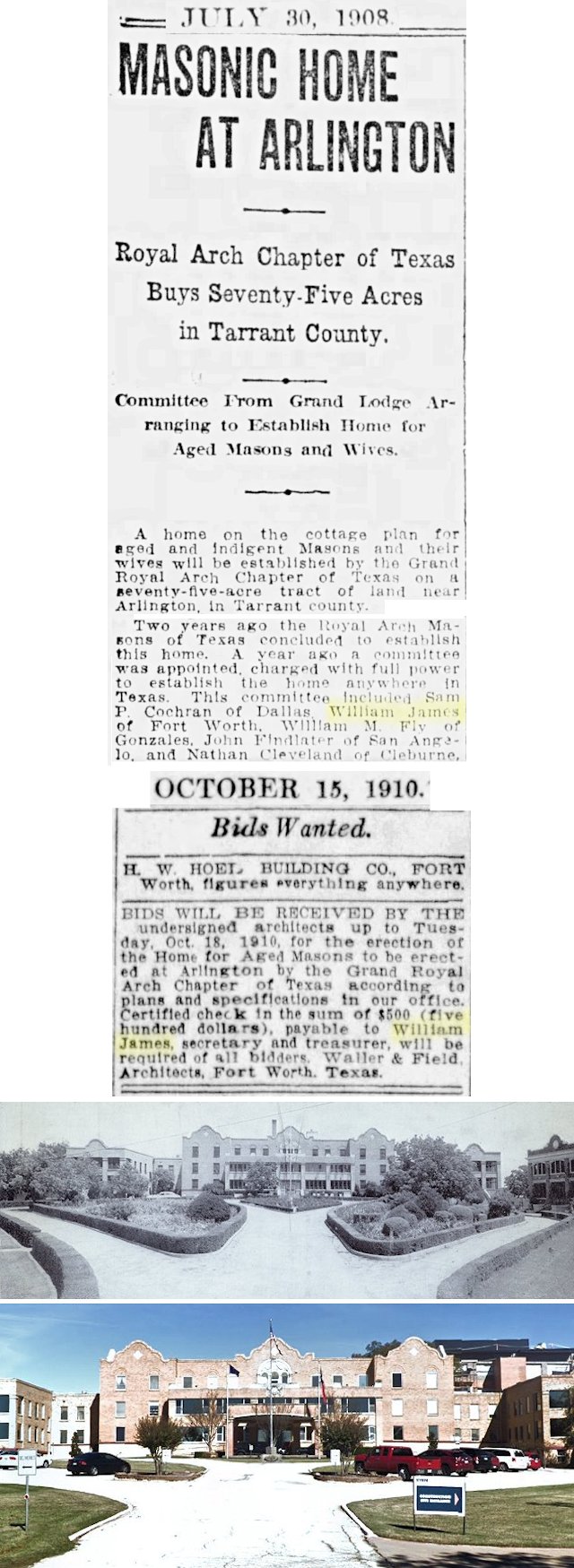
Also in 1908 William James helped plan a “Home for Aged Masons” in Arlington.
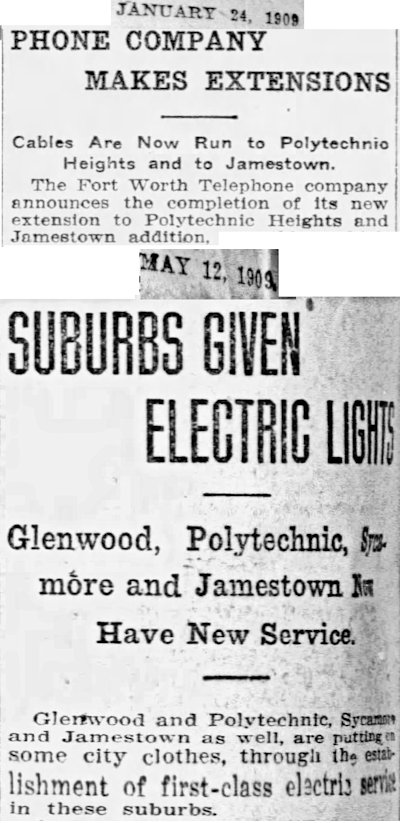
By 1909 telephone and electric service had been extended to Jamestown.
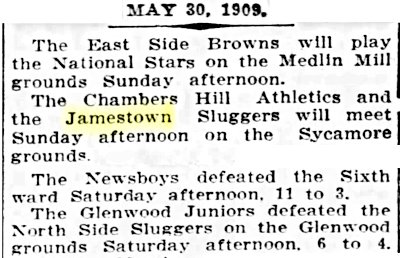
Early in the twentieth century companies, churches, and other groups (such as Medlin Mill, newsboys, Glenwood, Jamestown, Chambers Hill, Sixth Ward) organized baseball teams to compete in local amateur leagues. (Chambers Hill is just east of downtown where the Butler Place federal housing project was built.)
Also in 1909 William James was among Poly residents who subscribed money to buy land for Sycamore Park on Sycamore Creek. Other subscribers included Reverend H. A. Boaz of the college and Poly civic leader S. S. Dillow.
James also took part in the debate in 1909 when Poly residents considered seeking annexation by the city of Fort Worth. James favored annexation for the greater good of Poly but was wary of how businesses such as his would be taxed by the big city.
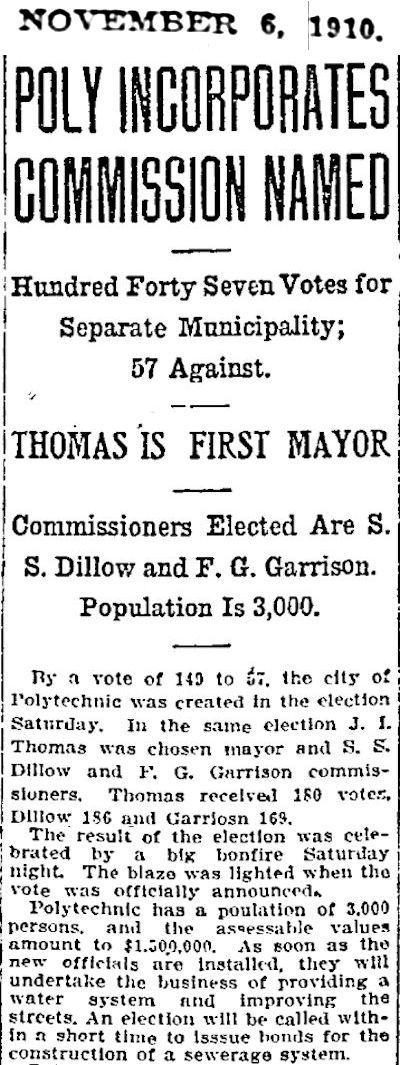
That point turned out to be moot. Instead of being annexed by Fort Worth, in 1910 Poly incorporated. With incorporation Jamestown became a part of the city of Polytechnic Heights, ending the brothers’ hope that their namesake settlement would develop into a separate town.
William James’s son Thomas Randle Jr. in 1917 would be appointed city attorney of Polytechnic Heights. The new city would delay annexation until the “greater Fort Worth” land grab of 1922.
 This 1910 Star-Telegram photo shows “only a small part of the factory force” at Jamestown.
This 1910 Star-Telegram photo shows “only a small part of the factory force” at Jamestown.
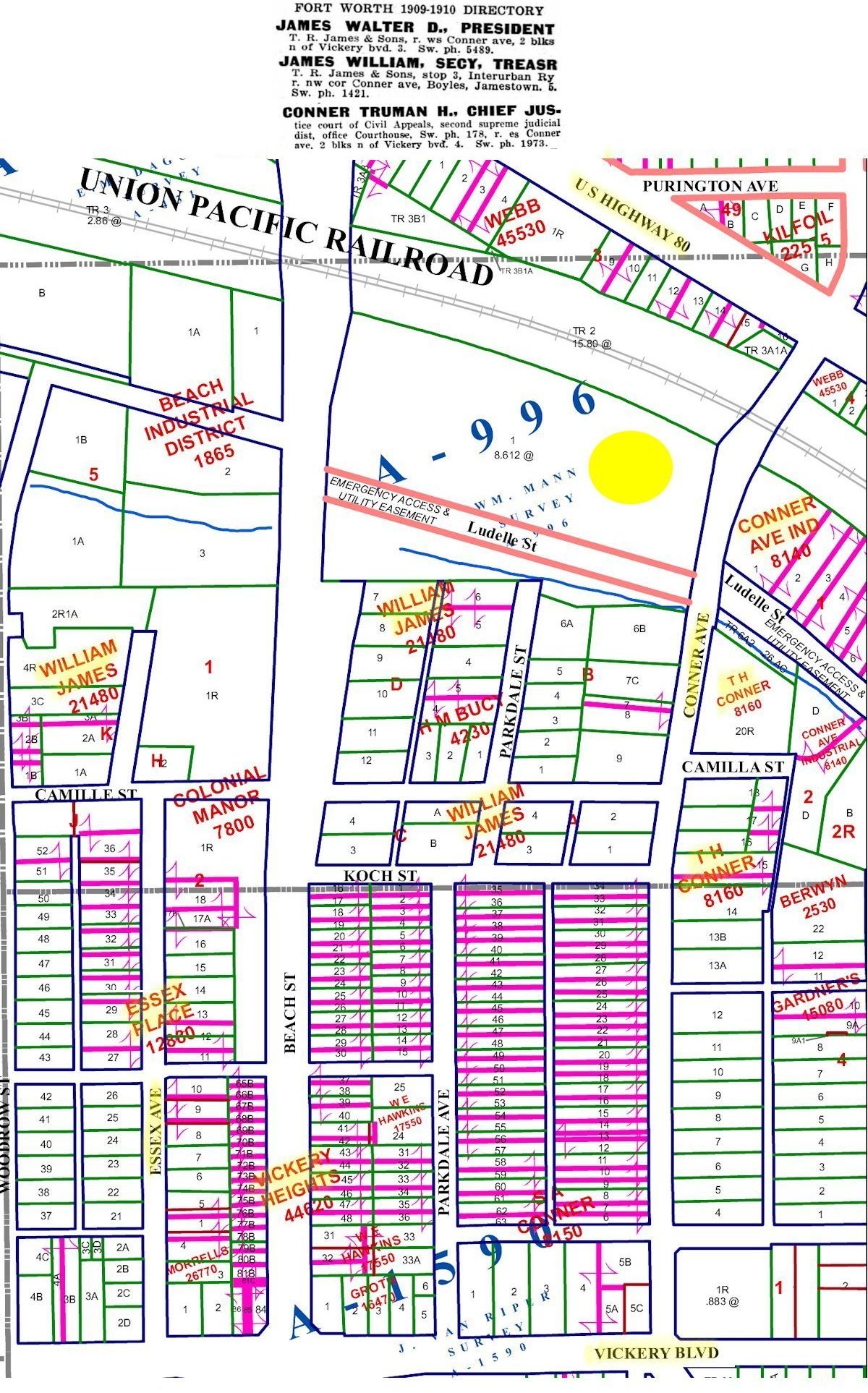
The yellow circle locates the James factory near today’s intersection of Beach Street and East Lancaster Avenue. The Conner Avenue industrial addition developed on the Jamestown property.
The William James additions, intended to providing housing for Jamestown workers, were just south of the factory.
Note in the 1909 city directory that William and Walter lived on Conner Avenue, which separates the William James additions from the Conner additions. Also living on Conner Avenue in 1909 was . . . Truman Holman Conner, for whom Conner Avenue and the Conner additions were named. Conner was—take a deep breath—chief justice of the Court of Civil Appeals of the Second Supreme Judicial District. At the time of his death in 1933 he was the second-longest-serving jurist in America (forty-six years).
(Vickery Boulevard and Vickery Heights namesake Richard L. Vickery would later live—and die—on Conner Avenue.)
Elsewhere on the map, Essex Place was developed by Winfield Scott Essex, who was a mayor of Poly before annexation. He lived on Vickery Boulevard at the entrance to his addition.
 One James family house on Conner Avenue survives at 600. (Thanks to Tom James for his help.)
One James family house on Conner Avenue survives at 600. (Thanks to Tom James for his help.)
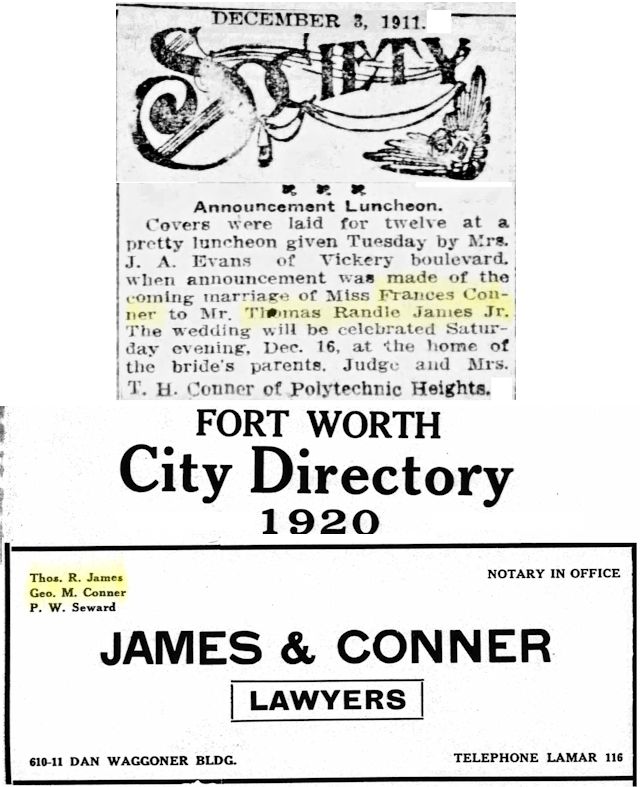 The Jameses and Judge Conner were connected by more than geography. William James’s son Thomas Randle Jr. married Judge Conner’s daughter Frances. And Thomas Randle Jr. was the law partner of Judge Conner’s son George.
The Jameses and Judge Conner were connected by more than geography. William James’s son Thomas Randle Jr. married Judge Conner’s daughter Frances. And Thomas Randle Jr. was the law partner of Judge Conner’s son George.

In 1911 the James brothers announced plans to expand and took on new partners—J. J. Mickle and brothers Peter E. and O. E. Schow—who provided more capital. With these changes came a new company name: “T. R. James & Sons” became “James Mickle Schow Company.”

Fast-forward three years. In 1914 no Jameses were listed as officers of James & Schow Company. The company was declared bankrupt, its assets sold.
The incorporation of Polytechnic in 1910 had killed the hope that Jamestown would become a separate city. In 1914 bankruptcy killed Jamestown’s raison d’etre.
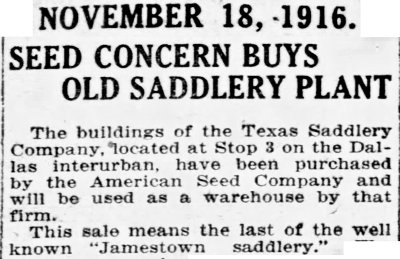
The James factory was bought by American Seed Company, which used the buildings for a warehouse and a box factory and used part of the Jamestown land as test beds for its flower and vegetable seeds.
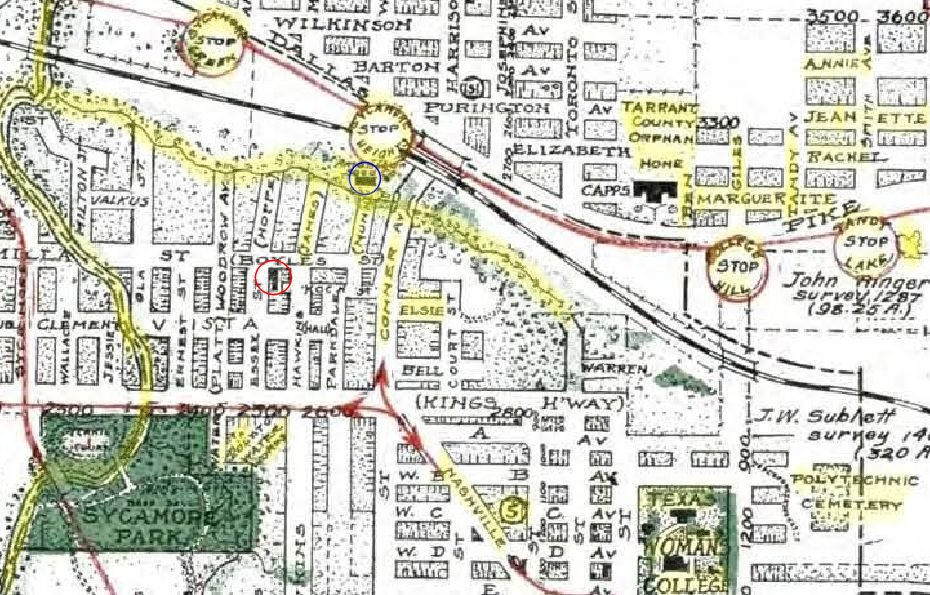
This 1920 map is rich in area history. The blue circle locates the James factory (labeled “American Seed” on this map) between the T&P tracks and the creek that Roger Tandy dammed in the nineteenth century to create Tandy Lake.
Just south of the factory note “James Street” and “Nunh Street.” Carl H. Nunh was vice president of the James company. Neither street exists anymore.
In 1920 Sycamore Creek was the western city limit of Poly.
Also shown are Tarrant County Orphans Home, Texas Woman’s College, and Polytechnic Cemetery.
On Nashville Avenue is the first (1907) Poly High School. The second Poly High School would be built a block west in 1922.
The map also shows the interurban stops for Sycamore Creek, Sycamore Heights, College Hill, and Tandy Lake. To the right of the Tandy Lake stop is the remnant of the lake.
North of the Tandy Lake stop is the Tandy addition, developed by Lewis Tandy, grandson of Roger. Originally the addition included streets with the names of seven Tandy siblings and the Tandy surname: “Ben, “Giles,” “Jeanette,” “Rachel,” “Marguerite,” “Annie,” Lewis,” and “Tandy.” Today only Ben, Lewis, and Tandy streets survive with their original names.
The city of Polytechnic’s waterworks was just northeast of Sycamore Park.
To the right of Conner Avenue is Elsie Street, named for a daughter of Judge Conner.
And see that red circle? That was Jamestown Lumber Company.
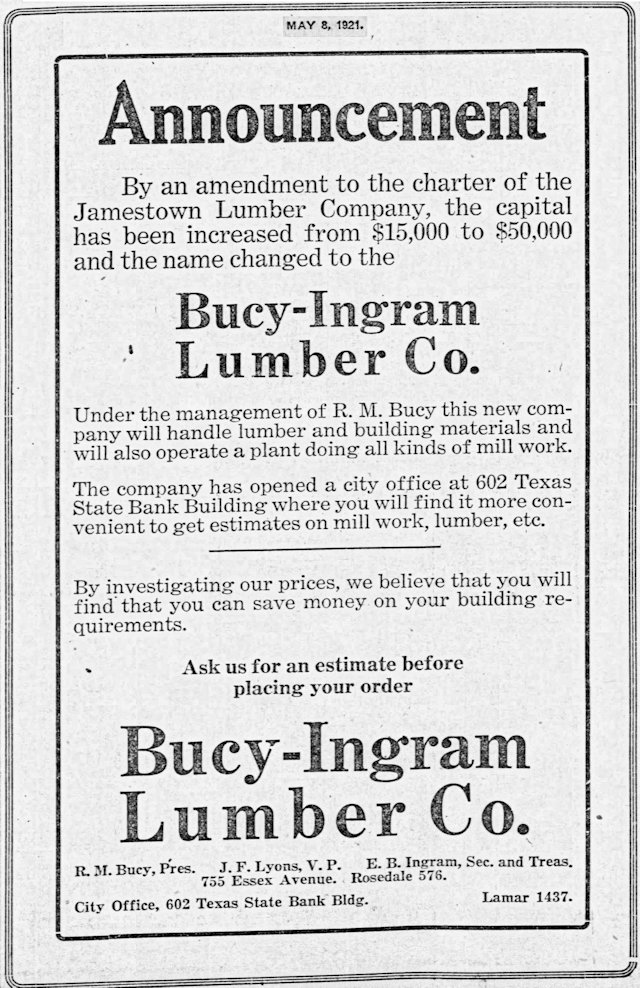
But in 1921 the lumber company changed its name to “Bucy-Ingram Lumber Company.”
Bucy-Ingram would be major lumber company in Fort Worth for more than seventy years.
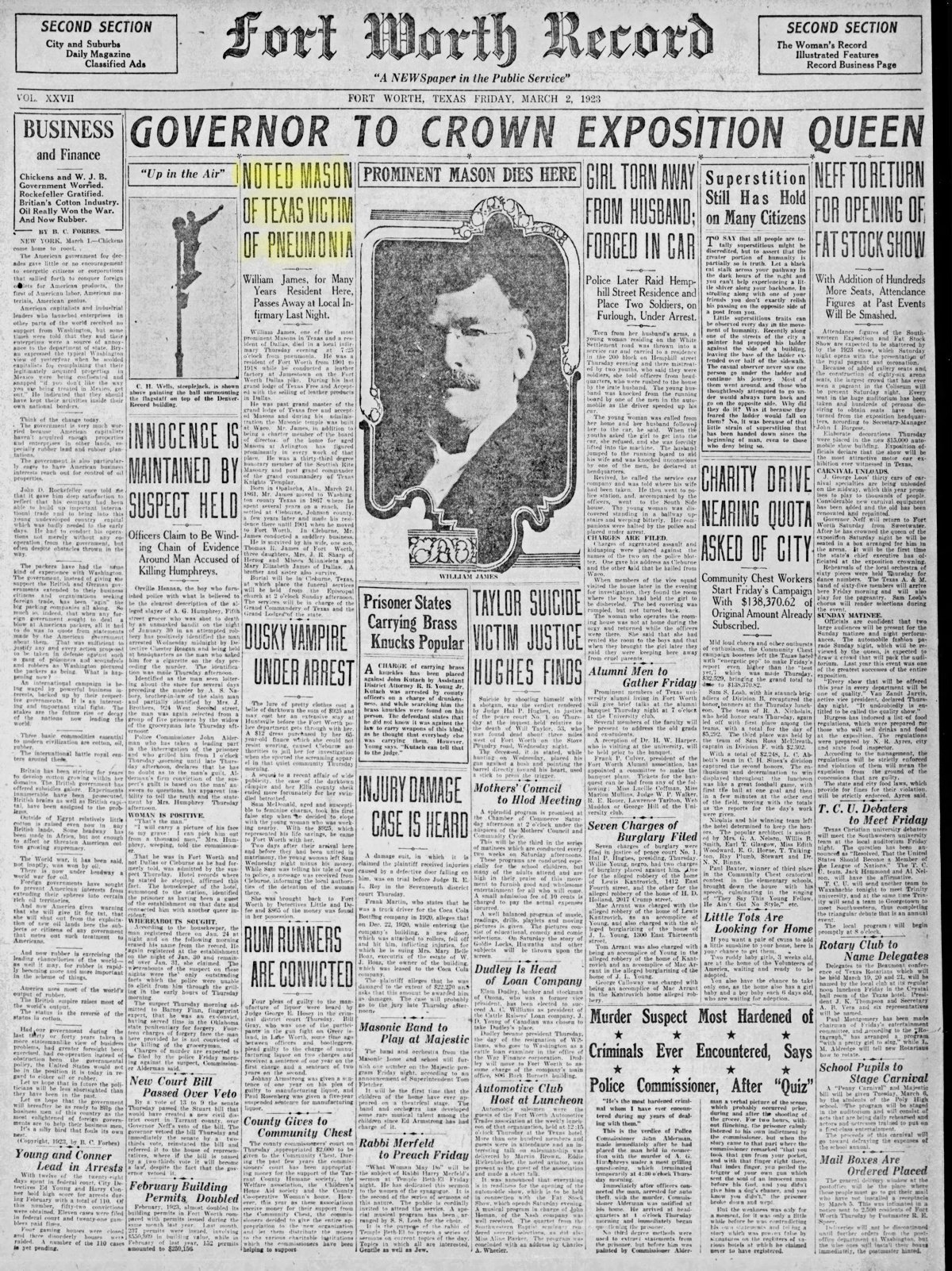
Jamestown was disappearing. In fact, William James himself left town, moving to Dallas to live his final five years. He died in Fort Worth on March 1, 1923. Northern Texas Traction Company dispatched a special interurban car to carry his body to Cleburne for burial. Two other special cars carried Masons, including those living at the home that James had helped to establish in Arlington.
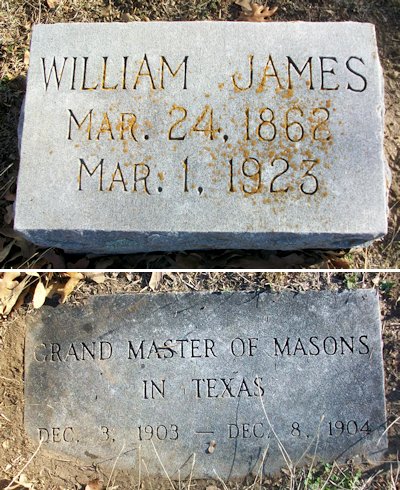
William James is buried in Cleburne Memorial Cemetery.
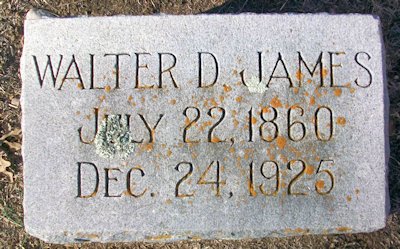
Brother Walter died in 1925. He, too, is buried in Cleburne Memorial Cemetery.
With both James brothers dead and T. R. James & Sons defunct, the name “Jamestown” fell out of use.
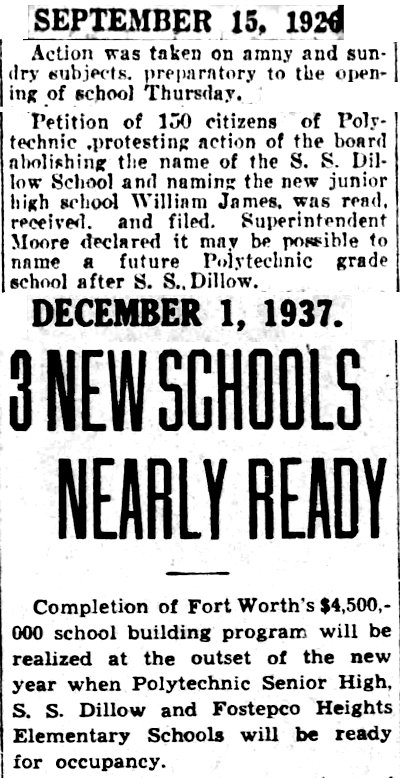
But in 1926 the Fort Worth school district named a new junior high school for William James. The school was located a half-mile south of the site of Jamestown and next to the first Poly High School building, which was also called the “Dillow School” in honor of the Poly civic leader.
With the opening of the new junior high school, the Dillow School building would be demolished, and 150 petitioners protested the retirement of the Dillow name.
But the name “Dillow” would reappear in 1937 with a new elementary school.

Likewise, 117 years after a “new city” of Jamestown was envisioned by two brothers from Cleburne, on Nashville Avenue the name of “James” lives on.
Posts About Education in Fort Worth






Hello, I am tying to find the history of 701 Conner Avenue Fort Worth, TX 76105. Thank you!
Thank you for visiting this site. Unfortunately the author, Mike Nichols, has passed away and we are working on a solution on how best to preserve it.